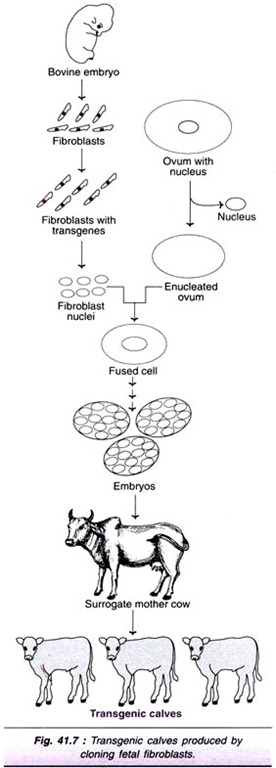ADVERTISEMENTS:
This article throws light upon the three types of bioreactors.
The three types of bioreactors are: (1) Mechanically Agitated Bioreactors (2) Pneumatically Agitated Bioreactors and (3) Wave Bioreactors.
Type # 1. Mechanically Agitated Bioreactors:
The mechanically agitated bioreactors are most commonly used for large-scale culture of plant, animal and microbial cells. In this type of bioreactor, the medium is agitated with the help of a mechanically driven impeller. Various types of impellers are in use, depending upon the requirement. Two traditional types of impeller used in this system are shown in figure. 28.3.
ADVERTISEMENTS:
Flat blade turbine impeller (Fig. 28.3A) with high speed is generally used in bacterial culture. High agitation breaks the incoming air into small bubbles. Since plant cells cannot tolerate high shear conditions and mixing of air may be a more serious problem with plant cell cultures, an alternate impeller, capable of inducing low shear have been used.
Marine propeller impeller is better suited for low shear mixing (Fig. 28.3 B). It provides axial mixing of the medium. On the other hand, flat-blade turbine promotes radial mixing. For large-scale systems, neither of these two types of impeller is used.
Alternatively, low-shear impellers (e.g., paddle and helical types) have been shown to more useful for plant cell cultivation. Since low agitation is insufficient to break incoming gas into small bubbles, incoming gas stream is dispersed as fine bubbles using an appropriate gas distributor. Enrichment of incoming gas with oxygen is beneficial.
Type # 2. Pneumatically Agitated Bioreactors:
Pneumatically agitated bioreactors are of two type’s viz., the bubble column and air-lift (Fig. 28.4). These bioreactors are tall and thin as compare to mechanical agitation type reactors. Typically, the height-to-diameter ratio in pneumatically agitated bioreactors is high. In bubble columns, air is bubbled at the base of the column and medium is agitated with this.
ADVERTISEMENTS:
In air-lift bioreactors, gas is sparged in the riser section and after the gas is disengages at the top of the column; the medium then flows downward in the down-corner section. These two sections may be separated using a baffle, a concentric cylinder, or an external loop. Circulation in the air-lift bioreactor promotes better mixing and therefore, has advantages in suspending cells and clumps more uniformly. But, in large-scale air-lift bioreactors, oxygen transfer rate is low in the down-corner section.
It should be emphasized that the performance of an air-lift bioreactor is strongly dependent upon the geometry of the system. Ratio of the cross-section area of the riser section and down- corner sections is of special importance because this ratio affects mixing and oxygen transfer.
Type # 3. Wave Bioreactor:
Wave bioreactor consists of a pre-sterilized flexible, plastic chamber that is partially filled with medium and inoculated with cells. The remaining part of the chamber is inflated with air. The air is continuously passaged through the head space during the cultivation mixing and mass transfers are achieved by rocking the chamber back and forth.
This rocking motion generates waves at the liquid air interface, greatly enhancing oxygen transfer. The concept of using rocking for agitation is used extensively for the agitation of liquids in laboratory assay plates and gels. In this disposable bioreactor, the cultivation chamber is discarded after harvest, eliminating any need for cleaning or sterilization.
The chambers are made of FDA approved biocompatible polyethylene. Special ports were developed to allow sterile addition or to withdraw samples without the need to place the bioreactor inside the laminar air flow cabinet. Theses bioreactors are available up to a working volume of 500L and due to wave motion known as Wave Bioreactor (Fig. 28.5).



